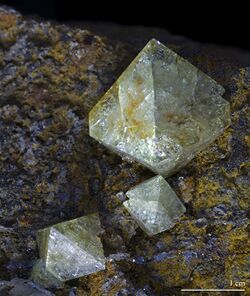Chemistry:Wardite
| Wardite | |
|---|---|
 Wardite from Rapid Creek – Yukon, Canada | |
| General | |
| Category | Phosphate minerals |
| Formula (repeating unit) | NaAl3(PO4)2(OH)4·2(H2O) |
| Strunz classification | 8.DL.10 |
| Crystal system | Tetragonal |
| Crystal class | Trapezohedral (422) H-M symbol: (4 2 2) |
| Space group | P41212 |
| Unit cell | a = 7.03(1), c = 19.04(1) Å; Z = 4 |
| Identification | |
| Color | White, colorless, pale green, blue-green, yellow-green, pale yellow, yellow pink. |
| Crystal habit | Dipyramidal pseudo-octahedral crystals, striated; radial, fibrous, encrustations |
| Cleavage | Perfect on {001} |
| Mohs scale hardness | 5 |
| |re|er}} | Vitreous |
| Diaphaneity | Transparent to opaque |
| Specific gravity | 2.81–2.87 |
| Optical properties | Uniaxial (+) |
| Refractive index | nω = 1.586 – 1.594 nε = 1.595 – 1.604 |
| Birefringence | δ = 0.009 |
| 2V angle | 0.0 |
| References | [1][2][3] |
Wardite is a hydrous sodium aluminium phosphate hydroxide mineral with formula: NaAl3(PO4)2(OH)4·2(H2O). Wardite is of interest for its rare crystallography. It crystallizes in the tetragonal trapezohedral class and is one of only a few minerals in that class. Wardite forms vitreous green to bluish green to white to colorless crystals, masses, and fibrous encrustations. It has a Mohs hardness of 5 and a specific gravity of 2.81–2.87.
Occurrence
It occurs with variscite in phosphate nodules and occurs uncommonly in pegmatites and phosphate deposits through alteration of amblygonite.
Wardite was named for Henry Augustus Ward (1834–1906) of the University of Rochester in New York. It first described in 1896 for an occurrence in Clay Canyon, Fairfield, Utah County, Utah, US. Though rare it has been reported from many locations worldwide.
See also
References
- ↑ Handbook of Mineralogy
- ↑ Mindat.org
- ↑ Webmineral data
- ↑ Warr, L.N. (2021). "IMA–CNMNC approved mineral symbols". Mineralogical Magazine 85 (3): 291–320. doi:10.1180/mgm.2021.43. Bibcode: 2021MinM...85..291W.
 |
